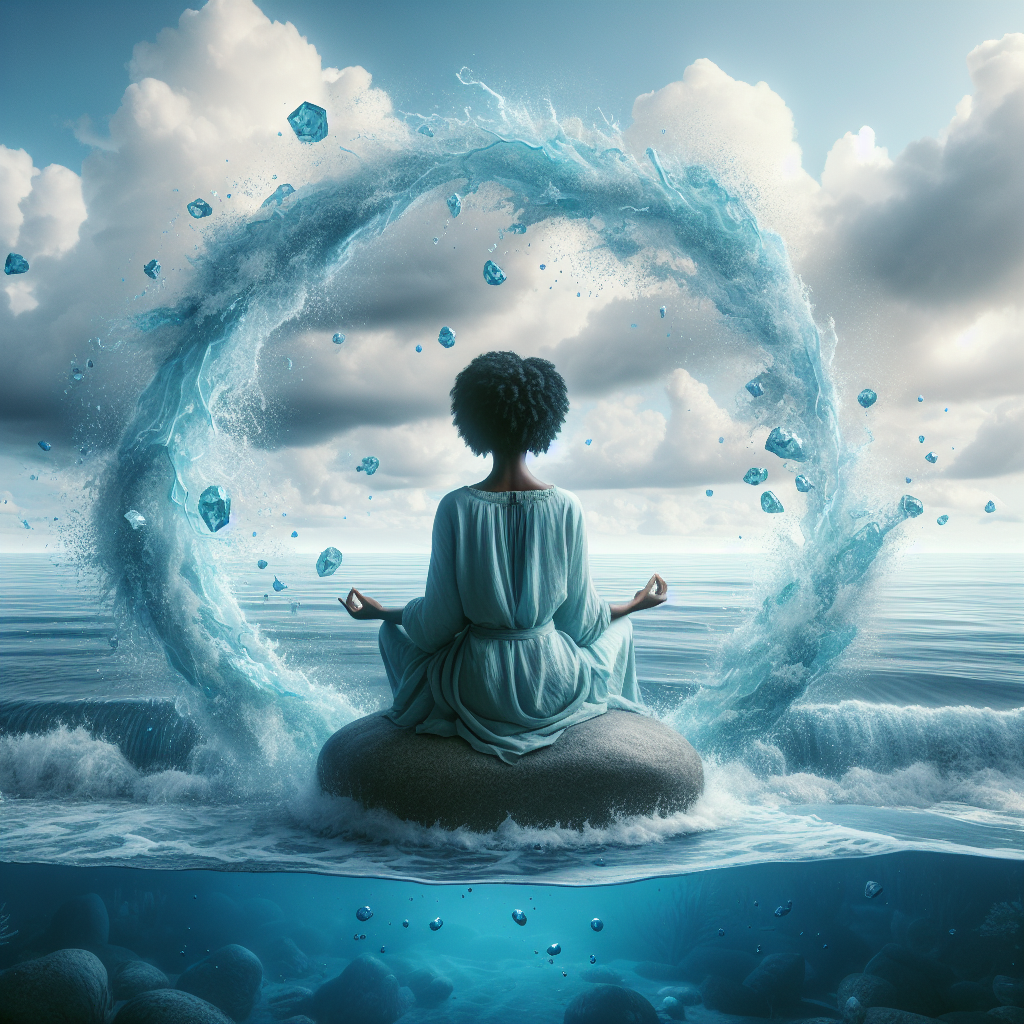As an Amazon Associate I earn from qualifying purchases.
↻
Last updated: December 24, 2025

Water covers about 71% of the Earth's surface and is vital for all known forms of life. Similarly, water is a powerful element in meditation practices, often used to symbolize purification, healing, and inner reflection. Water Elemental Meditation for Flow is a technique that harnesses the calming properties of water, encouraging practitioners to embody its fluidity and adaptability in both the mind and body.
Emerging from ancient practices that venerated the natural elements, Water Elemental Meditation for Flow has deep roots in various cultural traditions around the world. These include Taoism, which emphasizes harmony with nature, and Hinduism, where water is considered a purifier in rituals. In modern times, this form of meditation has gained relevance for its potential to reduce stress and enhance well-being, as individuals seek balance in an often turbulent world.
Engaging in Water Elemental Meditation for Flow can be a transformative experience, as one study suggests that individuals who incorporate such mindfulness practices report up to a 30% reduction in symptoms of anxiety and stress. This practice typically involves visualization techniques, where the participant imagines water flowing through and around them, clearing mental blockages and fostering a sense of peace.
Besides visualization, another aspect of the meditation might include physical contact with water, such as bathing or placing one's hands in a bowl of water. The tactile sensation serves as a focal point for concentration, allowing for a deeper immersion into the meditative state. By doing so, the practice takes on a multisensory dimension, which can help to anchor the individual in the present moment and encourage a more profound experience of meditation.
Water Elemental Meditation for Flow also encourages adaptability, an essential skill in today's fast-paced society. Just as water can move around obstacles with ease, this form of meditation inspires practitioners to adopt a more flexible approach to life's challenges. By embracing the fluid qualities of water, one can learn to navigate personal and professional hurdles with greater grace and resilience.
Incorporating breath work into the practice can further deepen the connection to the water element. Breath, like water, is essential to life and flows rhythmically through the body. By synchronizing one's breath with the visualization of flowing water, an individual can enhance the meditative experience, potentially increasing the positive impacts on mental clarity and emotional stability.
html
How Can Practicing Water Elemental Meditation Enhance Your Flow State?
Water Elemental Meditation is a transformative practice that taps into the characteristics of water—fluidity, adaptability, and power of gentle persistence—to promote a state of flow in the practitioner's life. By embodying the elements of water, individuals can learn to release resistance, adapt to circumstances with ease, and find a rhythm in their actions that aligns with their natural state of being. This kind of meditation can encourage emotional healing, relieve stress, and improve mental clarity. Engaging in Water Elemental Meditation can lead to a harmonious balance within oneself, much like a stream effortlessly navigating through the landscape, shaping its path with patient and persistent force. As we dive deeper into the topic, we will explore the specific techniques and benefits this meditative practice offers, guiding you toward a more fluid and graceful approach to the challenges of daily life.
Water Elemental Meditation for Flow
Meditation practices often draw inspiration from the elements of nature to create a connection between the individual and the external environment. Water, known for its flowing, adaptive, and powerful yet soft nature, serves as a perfect metaphor for mental and emotional flexibility. Water elemental meditation revolves around channeling the intrinsic qualities of water to nurture a sense of flow in one's consciousness.
Embracing the Fluidity of Mind
In water elemental meditation, practitioners envision themselves as embodying the fluid qualities of water. Through visualizations of streams, rivers, or oceans, one can tap into the ebb and flow of their thoughts with greater ease. The goal is to allow the mind to become pliable, using the fluidity of water as a mental model to let go of rigid thought patterns and embrace a state of adaptable flow.
Techniques and Practices
Guided visualization is a common technique within water elemental meditation. Participants might be instructed to imagine they are a river, meandering through landscapes, effortlessly overcoming obstacles – rocks, fallen trees – by flowing around them. This practice fosts a mental state that is resilient and open to change, embodying the water's perpetual movement.
Breathing exercises are another key component. Just as water flows in waves, so does the breath. Syncing one's inhalations and exhalations with the rising and falling of imaginary tides can deepen the meditative state, reinforcing the connection to the water element and promoting a sense of inner peace and flow.
The Ripple Effect of Consistency
Incorporating water elemental meditation into a regular practice is said to have a ripple effect on one's daily life. Engaging with these meditative techniques can improve emotional regulation, reduce stress, and enhance creativity. By visualizing oneself as water, practitioners often find that they become better equipped to navigate life's challenges with grace and ease, much like water shapes its path through the landscape.
Scientific Backing and Benefits
Several studies echo the anecdotal benefits of elemental meditation, particularly its impact on mental health. Research suggests that practices aiming to increase the psychological flow state can have positive effects on depression and anxiety, providing a mental space for practitioners to detach from negative thought spirals.
Beyond individual mindfulness practice, water elemental meditation holds a strong community aspect. Group meditations can create collective energy, echoing the interconnected nature of water systems within the environment. This collective practice can lead to a shared sense of peace and unity among participants.
In the broader context of mental wellness, water elemental meditation provides an accessible tool for anyone looking to enhance their mental flexibility and flow. According to a 2022 study published by the National Center for Complementary and Integrative Health, meditation practices have seen a significant increase in popularity, with 14.2% of American adults reporting having used meditation within the past year – a statistic that reflects a society increasingly turning towards mindfulness as a cornerstone of personal well-being.
html
FAQ: Water Elemental Meditation for Flow
1. What is water elemental meditation?
Water elemental meditation is a form of mindfulness practice where you focus on the qualities and energy of water to enhance relaxation and emotional flow. It often involves visualization and deep breathing to connect with the fluid, adaptable nature of water.
2. How can water elemental meditation benefit me?
Engaging in water elemental meditation can help reduce stress, increase emotional flexibility, enhance creativity, and promote a sense of tranquility. It's beneficial for anyone looking to find calmness and improve their mental well-being.
3. Do I need any special tools or equipment for this meditation?
No special tools or equipment are necessary for water elemental meditation. However, some individuals may prefer to have a bowl of water, recordings of water sounds, or even be near a body of water to deepen their connection during the meditation.
4. How long should a water elemental meditation session last?
A session can last anywhere from a few minutes to an hour, depending on your experience level and the time available. Beginners may start with 5-10 minutes and gradually increase the duration as they become more comfortable with the practice.
5. Can water elemental meditation help with insomnia?
Yes, many people find that the soothing qualities of water elemental meditation help them relax and release the tension that can contribute to insomnia, promoting better sleep.
6. Is water elemental meditation religious or spiritual?
Water elemental meditation can be practiced by anyone, regardless of their religious or spiritual beliefs. It's a versatile technique that focuses on the element of water as a source of mental and emotional harmony.
7. What is the best time of day to practice water elemental meditation?
There is no “best” time for everyone; it depends on your individual schedule and preferences. Some find it calming to meditate in the morning to set a positive tone for the day, while others prefer evenings to reflect and relax before sleep.
8. Can I practice water elemental meditation outdoors?
Absolutely! Practicing near a natural body of water like a river, lake, or ocean can enhance the effectiveness of your meditation by immersing you directly in the sights and sounds of the water element.
9. Is it normal to feel emotional during or after water elemental meditation?
Yes, connecting with the element of water can sometimes release pent-up emotions, leading to a sense of emotional release during or after the practice. This is generally considered a healthy part of the process.
10. How often should I practice water elemental meditation?
Regular practice can yield more noticeable benefits, so many practitioners aim for daily sessions. However, even occasional practice can contribute to your overall well-being. The key is consistency and finding a rhythm that works for you.

Conclusion
Water elemental meditation is a transformative practice that taps into the fluid nature of water as a metaphor for the flow of life and emotions. Embracing the qualities of water enables practitioners to cultivate a sense of fluidity and adaptability, much like a river meandering through the landscape. Throughout the article, we explored the key concepts of visualization, mindfulness, and the connection with the natural element of water. By envisioning oneself as part of the watery realm, meditators can learn to release resistance, manage stress, and adapt with grace to life’s ever-changing circumstances.
The techniques and approaches outlined, such as breathing exercises that mimic the ebb and flow of tides and the emphasis on emotional release, represent a path to inner peace and resilience. The water elemental meditation journey encourages individuals to embody the qualities of water—cohesion, purification, and life-giving sustenance—thus empowering them to navigate life's challenges with ease and tranquility. In integrating these insights into daily life, practitioners of water elemental meditation find themselves better equipped to flow harmoniously with both their internal states and the external world, fostering a deep, harmonious connection with the self and the environment around them.
Amazon and the Amazon logo are trademarks of Amazon.com, Inc, or its affiliates.
Continue Your Magical Journey
Free Witchcraft Starter Kit
Get 6 free printable PDFs: grimoire pages, moon calendar, spells, crystals, herbs, and tarot journal.
We respect your privacy. Unsubscribe anytime.
Enhance Your Practice
As an Amazon Associate, I earn from qualifying purchases.

